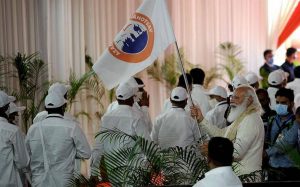Dandi March To Mark 75 Years Of Independence:

The Prime Minister has flagged off a commemorative ‘Dandi March’ (on 12th March) to launch the celebrations of the 75th year of Independence – ‘Azadi Ka Amrit Mahotsav’.
About the 2021 Dandi March:
- The padayatra is being undertaken by 81 marchers from Sabarmati Ashram in Ahmedabad to Dandi in Navsari, a journey of 386 km. The march will end after 25 days, on 5th April 2020.
- Descendants of those who walked the Salt March (in 1930) will be honored.
- Marchers will traverse the route in memory of the 78 who accompanied Mahatma Gandhi in 1930 from Ahmedabad to Dandi and two others who had joined mid-route.
- Big events will be organized at six places associated with Gandhi. These include MK Gandhi’s birthplace Porbandar, along with Rajkot, Vadodara, Bardoli (Surat), Mandvi (Kutch), and Dandi (Navsari).
- Cultural programs are planned at 21 spots on the route at the nightly stops for the walkers.
About the 1930 Dandi March:
- The Dandi March, also known as the Salt March and the Dandi Satyagraha was an act of nonviolent civil disobedience led by Mohandas Karamchand Gandhi.
- The march lasted from 12th March 1930 to 6th April 1930 as a direct action campaign of tax resistance and nonviolent protest against the British salt monopoly.
- On 12th March, Gandhiji set out from Sabarmati with 78 followers on a 241-mile march to the coastal town of Dandi on the Arabian Sea.
- There, Gandhi and his supporters were to defy British policy by making salt from seawater.
- At Dandi, thousands more followed his lead, and in the coastal cities of Bombay and Karachi, Indian nationalists led crowds of citizens in making salt.
- Civil disobedience broke out all across India, soon involving millions of Indians, and British authorities arrested more than 60,000 people.
- Gandhiji himself was arrested on 5th May, but the satyagraha continued without him.
- On 21st May, the poet Sarojini Naidu led 2,500 marchers on the Dharasana Salt Works, some 150 miles north of Bombay.
- The incident, recorded by American journalist Webb Miller, prompted an international outcry against British policy in India.
- In January 1931, Gandhiji was released from prison.
- He later met with Lord Irwin, the viceroy of India, and agreed to call off the satyagraha in exchange for an equal negotiating role at a London conference on India’s future.
- In August 1931, Gandhiji traveled to the conference as the sole representative of the nationalist Indian National Congress.
- The meeting was a disappointment, but British leaders had acknowledged him as a force they could not suppress or ignore.




